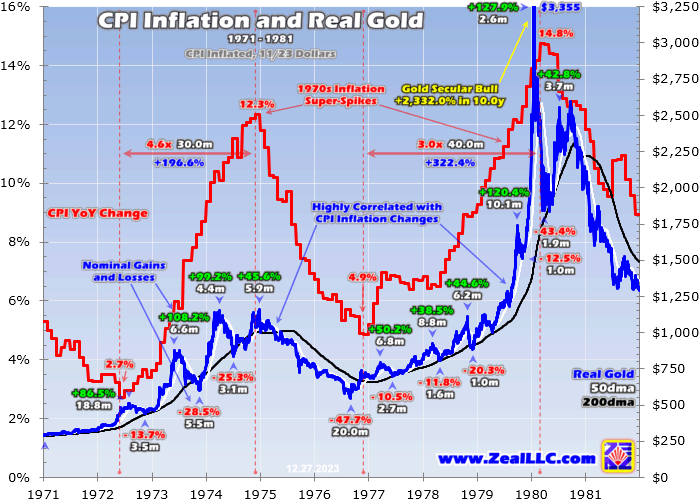 Mining.com: Real gold far from peak
Mining.com: Real gold far from peak
https://www.mining.com/web/real-gold-far-from-peak/

Gold is forging into new-record-high territory for the first time in several years. That is starting to generate some excitement, with financial-media coverage growing more frequent and bullish. That’s increasingly attracting back traders, who love chasing upside momentum on record breakouts. Despite these recent nominal records, gold remains far from its real inflation-adjusted peak implying it still has a long ways to run yet.
On December’s opening trading day, gold blasted 1.7% higher to a $2,071 close. That strength resulted from the Fed chair speaking at an Atlanta college. Traders expected him to wax hawkish and push back against loosening financial conditions. Instead he declared Fed monetary policy was already “well into restrictive territory”. So market-implied rate-cut odds for the FOMC’s mid-March meeting doubled to 80%!
While that was a big up day for gold, its absolute level was more interesting. That $2,071 was gold’s first new record high since early August 2020’s $2,062 fully 3.3 years earlier! Records usually run in streaks, as traders pile in to ride breakouts which accelerates them. But gold suffered a sharp pullback right after, on fears top Fed officials would soon unleash hawkish fury at their looming mid-December FOMC meeting.
Yet instead they surprised, pivoting dovish. The latest Federal Open Market Committee statement added a qualifier making further rate cuts less likely, top Fed officials cut their year-end-2024 federal-funds-rate projections by 50 basis points, and the Fed chair himself sounded dovish in his press conference! So gold soared 2.3% to $2,024 on that Fed Day, violently reversing its healthy pullback to rally higher since.
Mid-week gold was trading near $2,084, and closed at another record of $2,077. So a typical new-record streak is building despite being interrupted by incorrect FOMC expectations. While the great majority of both speculators and investors love chasing winners on record breakouts, contrarians have always been gold’s core constituency. We want to buy low before selling high, not buy high then hope for a greater fool later.
Despite gold’s nominal records, it isn’t yet extremely high in real inflation-adjusted terms. Reflecting the endlessly-eroding purchasing power of money, real prices are far more relevant over multi-decade timeframes. Central banks perpetually grow their money supplies, and gold is prized for staying ahead of that inflation. Since mining gold is so challenging, its global above-ground supply only grows about 1% per year.
That’s a stark contrast to central banks’ fiat currencies, which often increase an order of magnitude faster. The Fed’s balance sheet is essentially the US dollar’s monetary base, controlling the world supply of them. Even in normal non-crisis times, that is constantly climbing. In the decade ending 2019, the Fed grew its balance sheet 86.5% which annualizes to a 6.4% rate. But that trajectory radically steepened in early 2020.
Top Fed officials panicked after the pandemic-lockdown stock panic, when the flagship S&P 500 stock index cratered 33.9% in just over a month! So they frantically redlined their monetary printing presses for over two years after that. From just before that stock panic in late February 2020 to mid-April 2022, the Fed ballooned its balance sheet an absurd 115.6% in just 25.5 months for crazy-extreme monetary inflation!
That monetary base more than doubling in a couple years is the dominant reason inflation has raged in recent years. The FOMC finally realized how dangerous its extreme monetary excesses were in mid-2022 as reported inflation soared. So the Fed has shrunk its balance sheet 13.8% since then. Yet crazily over these past four years, that monetary base has still skyrocketed 85.4% tying the previous decade’s growth!
That annualizes to a shocking 16.7% growth rate, well over an order of magnitude larger than gold’s world mined-supply growth! Unlike fiat currencies, gold can’t be conjured into existence by central banks. That natural scarcity is the main reason this leading alternative asset has been universally valued for millennia. No matter how extreme governments debasing their currencies becomes, gold preserves purchasing power.
That has seriously eroded in recent years thanks to the Fed’s epic monetary largesse. The most-closely-watched inflation gauge is the US Consumer Price Index. The Bureau of Labor Statistics in charge of it defines the CPI as “a measure of the average change over time in the prices paid by urban consumers for a market basket of consumer goods and services.” But the CPI chronically understates real-world inflation.
During these last four years where the Fed’s balance sheet soared 85.4%, the headline CPI has merely climbed 19.5%! Does that sound righteous to you? Are the prices you are paying for goods and services only about 20% higher than pre-pandemic levels? Anyone running a household or business has likely seen the prices they are paying soaring 50% to 100% in that timeframe! We all wish they were only up 20%.
The BLS has long intentionally lowballed the CPI for political reasons. Excessive money-supply growth is a devastating stealth tax on wealth, so Americans despise it. Politicians want to hide actual inflation from voters, otherwise they’d be run out of office. Higher reported inflation also limits government spending on multiple fronts. Politicians hate that, as they want to expand spending to bribe their constituents for votes.
The higher reported inflation, the higher prevailing interest rates. Those leave government borrowing and servicing debt more expensive, constraining its expansion. Higher rates also consume larger fractions of government budgets, restraining discretionary spending. They also increase transfer payments indexed to inflation, also leaving less money for politicians to spend. So they are loath to honestly report inflation.
General price levels Americans are paying have climbed faster than the CPI for the decades I’ve been studying both. Various statistical distortions the BLS uses to manipulate the CPI to placate its political masters have continually underreported true inflation. But that makes the CPI very conservative to use to illuminate real gold prices. Annualized CPI growth since late 2019 is only running 4.5%, which is laughable.
Gold’s real all-time-record high was seen in late January 1980, when prices skyrocketed to $850 nominal. That capped a mighty 10.0-year secular bull at life-changing 2,332% gains! That peak gold price inflated using the lowballed CPI as of its latest November 2023 print translates into $3,355 in today’s dollars! Gold won’t hit real records until at least that is exceeded, which is another 62% higher from mid-week levels.
Here’s a chart of gold’s 1970s super-bull rendered in current-dollar purchasing power as claimed by the CPI. Underneath those real gold prices are the CPI inflation rates, which were far-more honest back then. The political manipulation of key economic data has soared since, especially in the Biden years. Gold’s bull-market trajectories closely mirrored underlying monetary inflation, which gold stayed way ahead of.

Gold is certainly high today challenging $2,100, but remains far from that $3,355 real peak. And $2,100+ gold in today’s dollars wasn’t a short-lived phenomenon back then. Gold first blasted above there in early January 1980, then didn’t fall back below for good until early January 1981. Gold was higher than today’s levels for fully 3/4ths of that 12.2-month span! Real gold soared way higher during the last inflation super-spike.
Nothing attracts investors to gold like new record highs. Early this month when gold achieved that first new nominal record close in over several years, gold’s latest upleg merely extended to 13.8% gains over 1.9 months. That’s still small by recent standards, and trivial by 1970s standards. Over 7.2 months into early May 2023, the last gold upleg powered up 26.3%. So many more records are coming as this upleg matures.
The last gold upleg achieving streaks of nominal record highs crested in early August 2020. During that gold soared 40.0% in 4.6 months, achieving 30 new record closes in that span! Those records put gold back on investors’ radars, who then swarmed back in droves to chase gold’s strong upside momentum. That was certainly evident in the best high-resolution daily proxy for worldwide gold investment demand.
That is the combined holdings of the globally-dominant GLD and IAU gold ETFs, which tend to mirror overall global investment demand reported quarterly by the World Gold Council. During that mid-2020 gold upleg achieving those last record closes, GLD+IAU holdings soared 35.3% or 460.5 metric tons! Investors were buying GLD and IAU shares faster than gold was rallying, forcing these ETFs to buy gold bullion.
These physically-backed ETFs are designed to track gold prices. That’s only possible if differential ETF-share supply and demand is shunted into the underlying metal. These gold ETFs act as conduits for the vast pools of stock-market capital to slosh into and out of gold. GLD+IAU builds reveal their shares being bid up faster than gold itself. That quickly forces gold-ETF-share prices to decouple from gold’s to the upside.
The gold-ETF managers avert this tracking failure by creating sufficient new ETF-share supply to absorb excess demand. Then the cash proceeds from issuing these new shares are immediately plowed into more physical gold bullion. Identifiable investment demand in today’s young upleg forging into record territory has barely started per GLD+IAU holdings. They edged up only 0.2% as gold rallied 14.2% into mid-week!
The more new nominal records this current upleg achieves, the more investors will flood in to chase it and amplify its gains. And many new records are coming. If today’s upleg merely grows to 25%, that would carry gold up near $2,275. And if mounting investment demand strengthens it to 40%, we’d be looking at almost $2,550 gold. Of course both would remain way under early 1980’s $3,355 real peak in today’s dollars.
Interestingly gold soaring to new real record highs in coming years isn’t too much of a stretch. Since February 2020 just before that pandemic-lockdown stock panic, the Fed’s balance sheet has ballooned 85.7% higher. Gold normalizing from there to reflect this still-almost-doubled money supply would require it to surge over $2,925! And that’s ignoring other far-higher money supplies of other major world central banks.
There aren’t just far-more US dollars now to chase relatively-much-less gold, but far-more euros, yuan, yen, pounds, francs, and other dollars including Canadian and Australian ones! Top Fed officials weren’t the only central bankers panicking in early 2020 and spinning up their printing presses since. Eventually gold prices will normalize where global above-ground gold supplies reflect vastly-expanded global money supplies.
That equilibrium will have to be reached far above $2,100 gold, likely at levels few traders today believe possible. The longer and higher gold rallies in coming years, the more enthusiasm and bullishness it will generate. This becomes a self-feeding virtuous circle, higher gold entices in more capital which bids gold higher still. This dynamic could ultimately snowball into a popular speculative mania like during the late 1970s.
As gold skyrocketed parabolic on gargantuan capital inflows, its final two uplegs of that mania swelled to huge 120.4% gains over 10.1 months then another 127.9% over 2.6 months! That gold mania climaxed with a terminal final-month 79.7% moonshot to that all-time real peak! While traders sure can’t plan on speculative manias and bubbles, enough new record gold highs will tilt the odds more in another one’s favor.
But all that really matters in coming months is gold’s next step. Again if this young upleg merely grows to +25%, gold would have to rally near $2,275 which would mean a long streak of nominal record highs. They would attract back big investment capital, accelerating gold’s gains. Again gold’s last record-streak-driven upleg in mid-2020 grew to a monster +40%, which would translate to almost $2,550 in today’s upleg.
The biggest beneficiaries of higher gold prices remain the gold miners’ stocks. The leading GDX gold-stock ETF surged 63.9% during gold’s last 26.3% upleg that topped in early May 2023, making for 2.4x upside leverage. In that mid-2020 40.0% gold upleg with record-high streaks, GDX soared 134.1% amplifying gold’s gains by an awesome 3.4x! Typically the major gold miners of GDX leverage gold by 2x to 3x.
But smaller fundamentally-superior mid-tier and junior gold miners tend to well outperform the majors. They are better able to consistently grow their production from smaller bases, which investors prize over everything else. And their smaller market capitalizations make them much easier for capital inflows to bid their stocks way higher. Our newsletter trading books are currently full of still-cheap great smaller gold miners.
The bottom line is real inflation-adjusted gold prices remain far from their peak. While $2,100 gold is high, its January 1980 peak translates into $3,355 in today’s dollars per the intentionally-lowballed CPI. Gold spent the better part of a year after that trading higher than current levels in real terms. So these prices are nowhere near extreme, gold still has lots of room to power much higher from here which is really bullish.
All gains going forward will drive gold deeper into record territory. More record closes will really boost bullish financial-media coverage, getting gold back on investors’ radars. Those guys love chasing upside momentum, and their big buying will really accelerate gold’s upleg. The more investment capital flows into gold, the longer and higher it will rally, and the more investors it will attract. Record-streak uplegs grow huge.
(By Adam Hamilton)
































